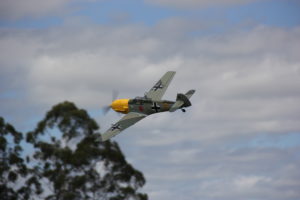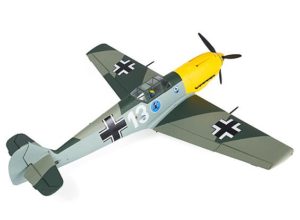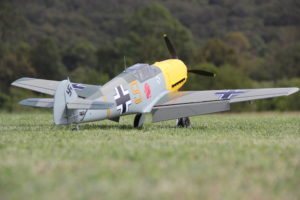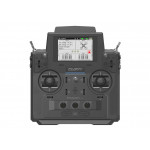
Durafly has finally released the highly anticipated Bf.109 and it's sure to excite.
This model is highly detailed and so well finished that it’s sure to excite even the most discerning scale aficionados among us. Like their previous warbirds in this class, they left no detail out and the scale nuts will want for nothing. I’ve owned both the Durafly T-28 and Spitfire and I can say that there is no contender in the market today and they’re simply the best representations of the models and they’ve again outdone themselves on the BF.109.
Features
- Superb handling on the ground and in the air
- Wide flight envelope with stable and scale flight performance
- Smoothest EPO on the market
- High scale fidelity and detail. Most scale foam Bf.109 ever produced
- Water-based, durable, and authentically color matched paint
- Superior vinyl material decals with multiple scheme options
- Scale working bomb drop system included
- Extensive use of glass and carbon fibers for low weight/high strength
- Plug and Fly, simply add Rx and Lipoly battery
- Quick assembly
- Pre-installed scale electric retracts
- Functioning scale flaps
- Operating pre-installed navigation LED lighting
Specs
| Specs | |
|---|---|
| Wingspan: | 1100mm (43.3”) |
| Flying Weight | 1300-1400g |
| Motor | Aerostar 3736-770KV |
| ESC | Aerostar 50A |
| Propeller | 11.5x8 3-Blade |
| Servo | 7 x 9g, 2 x Ailerons, 2 x Flap, Elevator, Rudder, Bomb Release |
| Battery | 2200mAh 4S LiPo (not included) |
The model comes well protected with each part being individually wrapped and placed into the box. The model is double boxed and well protected with an EPS foam box. The contents of the box have everything that is required are as follows.
- Fuselage
- Wing set
- Horizontal Stabilizer
- Propeller
- Nosecone
- Screw Bag
- Control Horns
- Bomb Release and Bomb
- Scale Plastic Pieces
Like the other models in the Durafly range, the assembly is quite straightforward and covered in the manual. Assembly should take around 30 minutes however the decal application may take the longest. Durafly did not recommend decal placement however there are many options to choose from. The ball joints and ball links are easily installed and move freely and in fact, I’ve always found those to be good quality.
The PNF model is equipped with a powerful 3736-770KV brushless outrunner, 50A ESC, LED NAV lights, and scale wheels and only requires a receiver and battery of your choice and you’re good to go. The ESC and motor are Aerostar and designed to be run on a 4S 2200mah 25c pack. I used a Turnigy Graphene 65C pack and found the power was consistent throughout the flight. This appears to be a quality associated with the graphene packs not necessarily the powertrain. A 4S pack will provide more than enough power in this model, however, I also ran this model on 3S to see what the outcome might be and although it flew fine it lacked power and had no vertical climb although if you just wanted to fly around and not expect too much then 3S might be a great way to keep the weight down.  The landing gear is fairly solid and raked forward to assist with landing. Warbirds have a terrible tendency of nosing over upon take-off and the Bf.109 can be a little tricky and will require a few landings to get the hang of it. The PNF model is equipped with a powerful 1200kv brushless outrunner, 20A ESC, LED nav lights, and scale wheel pants and only requires a receiver and battery of your choice and you’re good to go.
The landing gear is fairly solid and raked forward to assist with landing. Warbirds have a terrible tendency of nosing over upon take-off and the Bf.109 can be a little tricky and will require a few landings to get the hang of it. The PNF model is equipped with a powerful 1200kv brushless outrunner, 20A ESC, LED nav lights, and scale wheel pants and only requires a receiver and battery of your choice and you’re good to go.
HobbyKing is known the world over for affordable model aircraft and in keeping with tradition the Cessna comes in at under $100. The Cessna Skylane is a much loved iconic aircraft that aviation enthusiasts around the world will be very familiar with. Cessna started production of the Skylane from around 1956 onward with progressive changes as technology and customer requirements changed. The Skylane earned a reputation for reliability along with flight performance and the H-King representation is no exception. The aircraft captures the classic lines of its namesake and looks impressive in the air. The decals are expertly applied at the factory over a very modern blue scheme.
Flight-Report
I’ll say from the outset the model flies very well which was a surprise to me given the price point. I am naturally cautious of low priced aircraft, however, Hobbyking has certainly raised the bar in terms of acceptable quality and value for money. At its core, it is a forgiving general aviation aircraft but It also has the ability to kick it into sports mode if you give the throttle a nudge. The aircraft offers a surprising level of aerobatic ability which is something I wasn’t expecting.
Takeoff could not have been easier and was without incident. I moved the throttle forward allowing the Cessna to reach full throttle before adding up the elevator to rotate the aircraft. I found the front nose wheel may dig into a grass strip so simply add a little up elevator as you take off and this reduces the pressure of the front nose wheel. Very little trim was required to get the aircraft to fly straight and level. In addition, I noticed no pitch sensitivity at the suggested CG and found it quite acceptable.  The plane had more than enough power and in fact, I flew the plane at a half to a quarter throttle. Come to think of it, I have never heard anyone say a plane had too much power. It comes in handy to get you out of trouble and if you feel the plane is flying too fast my I suggest you get used to the proportional control of your throttle. An underpowered aircraft is little more than a recipe for disaster because if you’re in need of thrust to get you out of a bind and there is nothing there you’re going to have a bad day. The result is a crash and hours of time-consuming repairs. The aircraft is quite aerobatic with inverted flight, rolls, loops, tight circles, etc all within its flight envelope. The aircraft felt right at home in those maneuvers and in the air. For a little plane, it’s very stable in the air and a pleasure to fly.
The plane had more than enough power and in fact, I flew the plane at a half to a quarter throttle. Come to think of it, I have never heard anyone say a plane had too much power. It comes in handy to get you out of trouble and if you feel the plane is flying too fast my I suggest you get used to the proportional control of your throttle. An underpowered aircraft is little more than a recipe for disaster because if you’re in need of thrust to get you out of a bind and there is nothing there you’re going to have a bad day. The result is a crash and hours of time-consuming repairs. The aircraft is quite aerobatic with inverted flight, rolls, loops, tight circles, etc all within its flight envelope. The aircraft felt right at home in those maneuvers and in the air. For a little plane, it’s very stable in the air and a pleasure to fly.
The Hardware
The finish on the foam is wonderfully smooth and something I did not expect at this price point. The hinges on the wings, elevator, and rudder are made from the foam. Mine was not particularly stiff however I was sure to bend them a number of times which allow the surface to move freely. The control horns are nylon using two screens which are diagonally opposed to secure them to the control surface. A well-fitting clevis joins the control rod to the control horn. The wheels are simple lightweight foam wheels and are held in place by c-clips.
The electrical system is comprised of generic parts however we had no issues. I gave both the powertrain and the servos a very hard time looking to see if anything would fail and everything held up very well. I must say that I’ve come to expect more from HobbyKing as they have matured over the years. Their low price point models often exceed the quality that you’ve come to expect from the big name brands. I cannot wait to see where they go over the next decade.
Flight Performance
The plane is a great flier once it's trimmed out and balanced to your liking. Like all warbirds, landings are its Achilles heel however it can be overcome with practice and plenty of it. The plane rolls, loops, hammerheads, inverts all with ease. This is by no means an exhaustive list of maneuvers but gives you some idea of what to expect.
Landing
 Landing success is all in your approach. Literally. They say, taking off is optional but landings are mandatory. The more landings you do the better you’ll become at it as practice makes perfect. Landing, in general, is, without doubt, the hardest and most nerve-racking part of the entire flight, particularly when you're just getting used to a new plane. It is often said that if you don’t get the approach right you’re not going to land right. They are right of course. If you’re trying to correct a poorly executed landing it quickly becomes a nightmare. Get a feel for the stall speed of the 109 by climbing to a safe altitude and then reducing throttle allowing the aircraft to slow until it stalls. Take note of what happens; does it drop a wing, drop the nose, or does something else happen.
Landing success is all in your approach. Literally. They say, taking off is optional but landings are mandatory. The more landings you do the better you’ll become at it as practice makes perfect. Landing, in general, is, without doubt, the hardest and most nerve-racking part of the entire flight, particularly when you're just getting used to a new plane. It is often said that if you don’t get the approach right you’re not going to land right. They are right of course. If you’re trying to correct a poorly executed landing it quickly becomes a nightmare. Get a feel for the stall speed of the 109 by climbing to a safe altitude and then reducing throttle allowing the aircraft to slow until it stalls. Take note of what happens; does it drop a wing, drop the nose, or does something else happen.
When you’re coming in for a landing you’ll want to land as slowly as possible so getting a feel for stall speed is very important and what it wants to do in a stall so you can be ready if it decides to stall. I found the 109 dropped its nose in a stall which prefer a nose to drop as opposed to a wing dropping. After lining up keep reducing throttle and let the aircraft settle into a mild descent. Don’t drop the nose to lose altitude, reduce throttle. Same for sinking too fast, don’t move the elevator but rather feed in more throttle. You will need to land with the throttle on and reduce over a few seconds once you land. Keep an eye on the tail as you may need to feed in the elevator to keep from nosing over. 5 seconds getting the aircraft into a steady descent. You will get better as you become used to the way the 109 flies.
Landing Procedure
- With the aircraft lined up with the centerline of the runway, reduce the throttle of the aircraft and keep the nose of the aircraft level.
- Use the throttle to control decent. Reduce throttle and put the aircraft into a gentle glide.
- As the aircraft slows down the wings produce less lift and the aircraft will start to descend. If the aircraft is not descending fast enough reduce throttle further and don’t drop the nose as this increases airspeed.
- Monitor the speed of the aircraft and if required apply a little throttle but try not to adjust the elevator. You may find a blip or two of the throttle is enough.
- Once on the centerline of the runway keep the aircraft level, from side to side ie wings level, and nose to tail level. Use the ailerons and/or rudder to make small smooth corrections to keep the aircraft on the centreline.
- Once your aircraft is just a few inches above the runway reduces throttle and continues to input up the elevator trying for as long as possible to bleed off all speed and lift.
- Flaring is achieved by pulling the nose of the aircraft up slightly and keeping it up, using the elevator. As the aircraft bleeds off speed it will lose lift and eventually settle on the runway.
- Once on the ground, the operator needs to ensure they continue to steer the aircraft along the runway using the rudder and elevator.
The two most important things for me are takeoff and landing. The Bf.109 can be a little tricky to take off and land if you’re not familiar with warbirds of similar vintage. As you begin to add throttle you will need to add a little up elevator as this style of aircraft has a tendency to nose over. In addition to the elevator, you may need to feed in a little rudder to counteract torque roll. After trimming out the aircraft I started to get a feel for how it flew and what I needed to look out for. I took the aircraft up high and begun to put it into a stall and although it dropped a wing it was gentle and recoverable. After getting a feel for stall speed and decided to get a few landings in and change packs so that I could really open the throttle and put it through its paces. The first few landings were a little tricky as I started to get a feel for how she flies. My flaps were set at 10mm for full flap travel and at this deflection, there was no change to pitch and the aircraft felt quite stable and settled into a gentle descent with throttle reduced.
The 109 will fly on a 2200mah 3s pack but with the recommend 2200mah 4s pack it really comes alive. On 4S the plane has a very impressive power to weight ratio at better than 1:1. Hobbyking is known the world over for affordable model aircraft and in keeping with tradition the Bf,109 comes in around $169.99 which is a steal. Having flown many warbirds in my time I’m happy to give my Durafly Spitfire a stablemate. I was fairly excited when Durafly first announced the 109 and I’m glad the wait is finally over. Happy Landings. Written by Gozarian
Hear it First: Join our Mailing List
Sign up to receive new product updates, exclusive discounts, news, and more!






